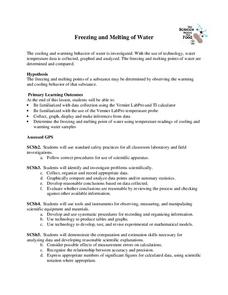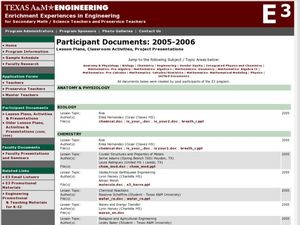University of Georgia
Heating and Cooling of Land Forms
Compare heating and cooling rates of different land forms. A lab activity has groups collect data on the rate of heating and cooling of soil, grass, saltwater, fresh water, and sand. An analysis of the rates shows how the different land...
University of Georgia
Freezing and Melting of Water
Examine the behavior of energy as water freezes and melts. An engaging activity provides a hands-on experience to learners. Collaborative groups collect data and analyze the graphs of the temperature of water as it freezes and then...
Curated OER
Oh Nuts! - Calories Count
Students measure and record the mass of the nut to be tested to the nearest 0.01 gram.
Curated OER
Snowflake Bentley
Learners explore crystals through the story Snowflake Bentley and then create crystal pictures of their own. In this interdisciplinary lesson, they create a crystal web chart on chart paper, design artificial snowflakes, and write poems...
Judicial Learning Center
Law and the Rule of Law
We hear a lot about the importance of the rule of law, but most people do not really know what those words mean. The lesson is a webpage that defines the rule of law, explains why it is important in a democratic society and provides...
NC Cooperative Extension, Guilford County Center
Life Cycle Of Painted Lady Butterflies
The Very Hungry Caterpillar is the inspiration for this project-based learning activity. Kindergartners create a lifecycle chart for a butterfly with four sections: egg, caterpillar, pupa, and butterfly. It is a three-dimensional...
Curated OER
The Influence of Carbon Dioxide on the Chemistry of Soda
Students investigate the carbon dioxide content of different sodas. In this chemistry lesson plan, students explain why PET containers are preferable than HDPE for soda bottles. They collect data and graph them.
Curated OER
Milk: A Practical Application
Explain the coagulation and coalescence processes associated with milk protein and cheese. List the components of milk and explain how each component is dispersed in the milk. Describe what happens when milk protein is coagulated Discuss...
Curated OER
Lab Management - Level II
Students who know what lab procedures are expected will work more effectively and be more successful during their lab experiences. See Preface Materials: Students decide upon lab partners and sign their names for each unit. Hand each...
Curated OER
Jody's Submarine Sandwich
In this science activity, students read a word problem about a submarine sandwich. Students answer 2 questions about the problem and complete a chart about the number of bacteria in the sandwich at different times.
Curated OER
Analyzing Birds and Planes
Students find a variety of topics and subjects in this lesson. In the math section of this lesson, students graph linear equations and analyze their data. They solve one and two step equations to find the variable.
Curated OER
The Kindness Company
Students organize themselves into a simulated company complete with applications, interviews and training. They identify a community need they can fulfill related to cooking or sewing and work to make and deliver the designated product.
Curated OER
Challenges of Sampling
In this sampling worksheet, students try different sampling methods to determine which is the best for determining contamination on a substance. This worksheet has 5 short answer questions.
Curated OER
Microbes and Health
Students participate in activities that show them how tiny germs are spread. For this germs lesson plan, students engage in hands on lessons to show them how microorganisms can easily spread disease through the mouth and hands.
Curated OER
Yeast Experiments
In this science worksheet, learners explore two experiments involving yeast. Students discover that yeast grows faster at room temperature than at hot or cold temperatures.
Curated OER
Cooking Up the Scientific Method
First graders identify the different steps of the scientific method. In this life science lesson, 1st graders apply this method when conducting a series of hands-on activities. They collect data and write observations in their journals.
Curated OER
Soil, Designer Soil: From Rainforests to the Prairie
Students explore the role and importance of soil in the ecosystem. In this Science and Social Studies instructional activity, students complete an experiment using various kinds of soil and clay and then examine how soil has a direct...
Curated OER
Introductions to Biotechnology
Although this PowerPoint has valid information, the 49 slides may not engage your students as much as necessary. Each slide has a title and 2 or 3 bullet points, but no images or external resource links to break up the information. ...
Curated OER
Agriculture: It Doesn't Just Happen
After reading an informational text on the Agricultural Research Service, learners research the role of the ARS in Oklahoma. Using reputable online sources, they label a map of the state with relevant areas. Researchers focus on one of...
Cornell University
Non-Newtonian Fluids—How Slow Can You Go?
Children enjoy playing with silly putty, but it provides more than just fun. Young scientists make their own silly putty using different recipes. After a bit of fun, they test and graph the viscosity of each.
Centers for Disease Control and Prevention
Teach Mrs. Jones' Class about Microbes
During a biology lesson, scholars research microbes, design a lesson plan using an outline, and present the lesson to the class.
Curated OER
Inuit Sled Dogs
This is a terrific resource! Have your class learn about Inuit sled dogs using this instructional activity. They discuss how the Inuit travel and the needs of their sled dogs. This instructional activity includes a math activity,...
Scholastic
Folk and Fairy Tale Readers: The City Mouse and the Country Mouse
Support the growth of your emergent readers with this printable version of the classic fable "The City Mouse and the Country Mouse." Including supporting illustrations and simple dialogue, this story is perfect for developing the fluency...
Cornell University
Buoyancy
Swimmers know to float by turning their bodies horizontally rather than vertically, but why does that make a difference? In an interesting lesson, scholars explore buoyancy and the properties of air and water. They test cups to see which...
Other popular searches
- Food Safety and Sanitation
- Food Safety Worksheet
- Food Safety Puzzle
- Food Safety Cycle
- Food Safety Lesson Plans
- Food Safety and Hygiene
- Food Safety Team Members
- Nutrition Food Safety
- Food Safety Storage
- Food Safety Procedures
- Government and Food Safety
- Food Safety Labs

























